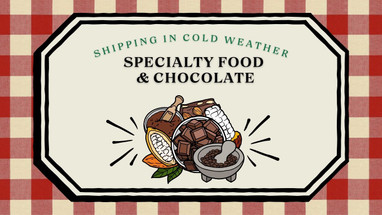Posted by UniHeatPacks on 30th Oct 2025
Specialty Food & Chocolate Shipping in Cold Weather
Cold weather doesn’t just threaten tropical plants or reptiles—it can ruin chocolate and gourmet foods too. Originally designed for shipping live insects, plants, and animals, UniHeat shipping warmers are now widely used in the specialty food industry to protect delicate confections, sauces, and artisan goods during winter transit. This article explains how to prevent cold-related damage and preserve product integrity when temperatures drop.
1) Why Cold Weather Damages Specialty Foods
Many premium foods—especially chocolates, nut butters, sauces, and pastries—contain fats and emulsifiers that are sensitive to temperature fluctuations. When exposed to cold, these components contract at different rates, causing bloom, texture changes, and separation. Condensation during reheating can also introduce moisture that leads to mold or spoilage.
- Chocolate: Rapid cooling causes sugar bloom, creating a gray film and gritty texture.
- Sauces and nut spreads: Oils may solidify or separate under 50°F.
- Pastries and baked goods: Can become stale or dense after temperature cycling.
For small-batch makers and specialty brands, a ruined product isn’t just a loss in revenue—it can affect reputation. Protecting temperature-sensitive foods during shipping is as important as packaging design or branding.
2) How UniHeat Warmers Transitioned from Live Shipments to Food Logistics
Since the late 1990s, UniHeat has been the trusted brand for transporting live insects, aquatic plants, and animals safely through cold conditions. Over time, specialty shippers realized that the same steady, oxygen-activated warmth that protects a coral frag or reptile egg can also stabilize the environment for temperature-sensitive foods.
Unlike hand warmers, UniHeat packs don’t spike in temperature—they release a gentle, controlled heat that prevents freezing and avoids overheating. This makes them ideal for fine chocolates, confections, and baked goods that require narrow temperature windows for quality preservation.
Pro Tip: Choose a warmer that maintains steady warmth, not one that overheats quickly. A consistent 70–75°F interior temperature helps preserve food texture and flavor without melting coatings or packaging seals.
3) Best Practices for Cold-Weather Food Shipments
- Insulate first: Use foam panels or insulated liners to buffer cold air and prevent condensation.
- Position the warmer safely: Tape the UniHeat pack to an inner wall or lid, away from direct contact with food.
- Vent for balance: Add two to four small vent holes in the outer carton to allow oxygen flow. UniHeat warmers require air to maintain steady heat output.
- Use breathable padding: Crinkle paper or bubble wrap helps distribute warmth evenly and prevents cold spots.
- Time your shipment: Choose 1–3 day shipping methods during extreme cold and activate the warmer 20–30 minutes before sealing the box.
Pro Tip: Don’t overheat delicate foods. One 40hr or 72hr UniHeat pack is typically sufficient for small insulated boxes. Use multiple warmers only for large multi-item shipments and ensure air space around each.
4) Choosing the Right UniHeat Pack for Specialty Food Shipping
| Warmer | Duration | Recommended Use |
|---|---|---|
| UniHeat 40-Hour Shipping Warmer | Up to 40 hours | Small boxes of chocolate or single-batch confections. |
| UniHeat 72-Hour Shipping Warmer | Up to 72 hours | Regional shipments of artisan foods or multi-item boxes. |
| UniHeat 96-Hour Mega Warmer | Up to 96 hours | Cross-country deliveries or international exports in severe cold. |
All UniHeat warmers are non-toxic, biodegradable, and safe for both food and live-animal shipments. They generate steady warmth through a simple oxidation process—no electricity, gels, or batteries required.
5) Frequently Asked Questions
Are UniHeat warmers food-safe?
Yes. While UniHeat warmers were originally developed for live insects, plants, and animals, they contain no harmful chemicals and can safely share shipping space with sealed food products. They are not intended for direct contact with food.
Can UniHeat packs prevent chocolate bloom?
They help reduce bloom risk by maintaining a consistent temperature inside the box. However, proper insulation and packaging are equally important to prevent cold spots and moisture condensation.
How many warmers should I use per box?
Typically one 40hr pack per cubic foot of insulated space. Adjust upward for larger boxes or extended routes during freezing temperatures.
Do I need to ventilate food shipments?
Yes. UniHeat packs require a minimal oxygen supply to activate. Two to four small holes in the outer carton provide enough airflow without significant heat loss.
What’s the difference between UniHeat and chemical hand warmers?
Hand warmers can reach unsafe temperatures above 130°F, potentially melting chocolate or packaging. UniHeat warmers maintain a much lower, safer range of steady warmth for sensitive goods.
About UniHeat: Since 1996, UniHeat has been trusted for live-animal, plant, and perishable shipping. Today, its same oxygen-activated technology supports safe winter deliveries for artisan foods and chocolates worldwide. Explore the full range of products at UniHeat.us.

